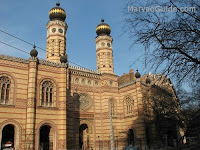Dohány Street Synagogue, Budapest:Pourtugal
 The
Dohány Street Synagogue also known as The Great Synagogue or Tabakgasse
Synagogue, is located in Erzsébetváros, the 7th district of Budapest.
It is the largest synagogue inEurope and the fifth largest in the
world.[citation needed] It seats 3,000 people and is a centre of Neolog
Judaism.
The
Dohány Street Synagogue also known as The Great Synagogue or Tabakgasse
Synagogue, is located in Erzsébetváros, the 7th district of Budapest.
It is the largest synagogue inEurope and the fifth largest in the
world.[citation needed] It seats 3,000 people and is a centre of Neolog
Judaism.
The synagogue was built between
1854 and 1859 in the Moorish Revival style, with the decoration based
chiefly on Islamic models from North Africa and medieval Spain (the
Alhambra). The synagogue's Viennese architect, Ludwig Förster, believed
that no distinctively Jewish architecture could be
identified,
and thus chose "architectural forms that have been used by oriental
ethnic groups that are related to the Israelite people, and in
particular the Arabs". The interior design is partly by Frigyes Feszl.
 The
Dohány Street Synagogue complex consists of the Great Synagogue, the
Heroes' Temple, the graveyard, the Holocaust memorial and the Jewish
Museum, which was built on the site on which Theodore Herzl's house of
birth once stood. Dohány Street itself, a leafy street in the city
center, carries strong Holocaustconnotations as it constituted the
border of the Budapest Ghetto.
The
Dohány Street Synagogue complex consists of the Great Synagogue, the
Heroes' Temple, the graveyard, the Holocaust memorial and the Jewish
Museum, which was built on the site on which Theodore Herzl's house of
birth once stood. Dohány Street itself, a leafy street in the city
center, carries strong Holocaustconnotations as it constituted the
border of the Budapest Ghetto.
History
Built in a residential area
between 1854-1859 by the Neolog Jewish community of Pest according to
the plans of Ludwig Förster, the monumental synagogue has a capacity of
2,964 seats (1,492 for men and 1,472 in the women's galleries) making it
the largest in Europe and one of the largest working synagogue in the
World, after the Belz Great Synagogue and the Beit Midrash of Ger in
Jerusalem, the Breslov Uman Synagogue in Uman, Ukraine and the Yetev Lev
D'Satmar synagogue in New York City. The consecration of the synagogue
took place on 6 September 1859.
The synagogue was bombed by the
Hungarian pro-Nazi Arrow Cross Party on 3 February 1939.Used as a base
for German Radio and also as a stable during World War II, the building
suffered some severe damage from aerial raids during the Nazi Occupation
but especially during the Siege of Budapest. During the Communist era
the damaged structure became again a prayer house for the
much-diminished Jewish community. Its restoration started in 1991 and
ended in 1998. The restoration was financed by the state and by private
donations.
Exterior
 The
building is 75 metres (246 ft) long and 27 metres (89 ft) wide.The
style of the Dohány Street Synagogue is Moorish but its design also
features a mixture of Byzantine, Romantic and Gothic elements. Two
onion-shaped domes sit on the twin octogonal towers at 43 metres (141
ft) height. A rose stained-glass window sits over the main entrance.
The
building is 75 metres (246 ft) long and 27 metres (89 ft) wide.The
style of the Dohány Street Synagogue is Moorish but its design also
features a mixture of Byzantine, Romantic and Gothic elements. Two
onion-shaped domes sit on the twin octogonal towers at 43 metres (141
ft) height. A rose stained-glass window sits over the main entrance.
Similarly to basilicas, the
building consists of three spacious richly decorated aisles, two
balconies and, unusually, an organ. Its ark contains various torah
scrolls taken from other synagogues destroyed during the
Holocaust[citation needed].
The Central Synagogue in Manhattan, New York City is a near-exact copy of the Dohány Street Synagogue.
Interior

 The
torah-ark and the internal frescoes made of colored and golden
geometric shapes are the works of the famous Hungarian romantic
architect Frigyes Feszl. A single-span cast iron supports the
12-metre-wide (39 ft) nave. The seats on the ground-floor are for men,
while the upper gallery, supported by steel ornamented poles, has seats
for women.
The
torah-ark and the internal frescoes made of colored and golden
geometric shapes are the works of the famous Hungarian romantic
architect Frigyes Feszl. A single-span cast iron supports the
12-metre-wide (39 ft) nave. The seats on the ground-floor are for men,
while the upper gallery, supported by steel ornamented poles, has seats
for women.
Franz Liszt and Camille Saint-Saëns
played the original 5,000 pipe organ built in 1859. A new mechanical
organ with 63 voices and 4 manuals was built in 1996 by the German firm
Jehmlich Orgelbau Dresden GmbH.